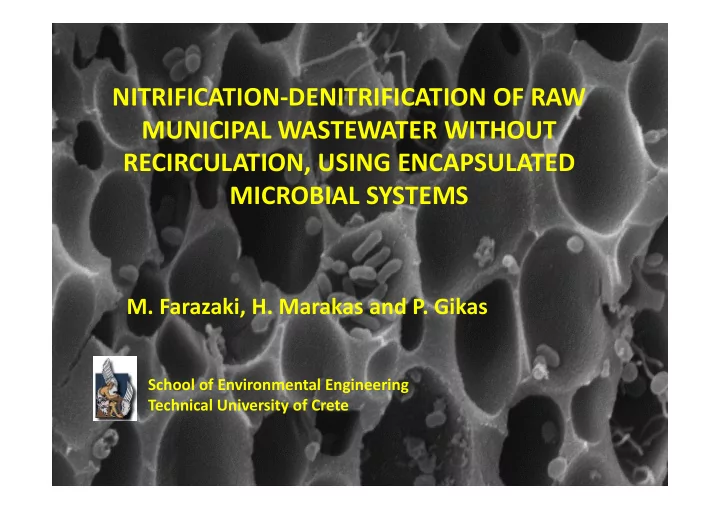

NITRIFICATION ‐ DENITRIFICATION OF RAW MUNICIPAL WASTEWATER WITHOUT RECIRCULATION, USING ENCAPSULATED MICROBIAL SYSTEMS M. Farazaki, H. Marakas and P. Gikas School of Environmental Engineering Technical University of Crete
Typical wastewater treatment plant ΕΕΛ2 School of Environmental Engineering Technical University of Crete
Conventional activated sludge process with nitrfication/denitrification BackWash flow R Inlet Tertiary Primary Secondary Denitrifi Disinfection Aeration filter clarifier clarifier cation Bar Outlet screen Air R Biosolids School of Environmental Engineering Technical University of Crete
Energy distribution in conventional municipal wastewater treatment plant Energy requirements in an issue of increased concern, as about 0.5-0.7 kWh/m 3 are required for treatment Aprox. 60% of the energy consumption is used for aeration Aprox. 12% of the energy consumption is used for primary sludge management School of Environmental Engineering Technical University of Crete
How It Works Microscreen ‐ Operating principle School of Environmental Engineering Technical University of Crete
Microscreen a. Microscreen with open housing b. Sludge removal (~45% TS) c. Microscreen cloth (100-350μm openings) a b c
Microscreen (Patra, Greece) School of Environmental Engineering Technical University of Crete
How It Works Footprint requirements Wastewater flow: 4000m 3 /d: Microscreen footprint: 4 m 2 Clarifier footprint: 82 m 2 1 ÷ 20 School of Environmental Engineering Technical University of Crete
Upflow sand filters, Adelanto, California (15000 m 3 /d) School of Environmental Engineering Technical University of Crete
Upfront solids removal (USR) process with biosolids gasification BackWash flow Solids removal B/W Removal of dBOD & N B/W Denitrification Trickling Microscreen Inlet Polishing filter Primary filter Bar Tertiary screen Disinfection filter R Outlet Electric energy Heat Syngas Biosolids co-generation Gasifier Dryer engine Solid residue School of Environmental Engineering Technical University of Crete
Upfront solids removal (USR) process with biosolids gasification BOD=90-130mg/L BOD=130-160mg/L μ heterotrophic d BOD=90-130mg/L d BOD=90-130mg/L >μ autotrophic N-NH4+=0-2mg/L N-NH4+=25-50mg/L N-NO 3 - =25-50mg/L CH 3 OH N-NO 3 - =0-2mg/L τ>μ htr Microscreen & Inlet Primary retained filter autotrophs Anoxic Oxic Bar screen Air BOD=90-130mg/L d BOD=90-130mg/L BOD=240-320mg/L BOD=90-130mg/L N-NH4+=25-50mg/L d BOD=90-130mg/L d BOD=90-130mg/L N-NO 3 - =0-2mg/L N-NH4+=25-50mg/L N-NH4+=0-2mg/L N-NO 3 - =0-2mg/L N-NO 3 - =2-5mg/L d BOD≈3.75N-NH 4 + School of Environmental Engineering Technical University of Crete
Scope of work Investigate the performance of encapsulated microbial systems for nitrification/denitrification Examine the feasibility of “once through” nitrification/denitrification system, with no need for addition of external carbon source Investigate the appropriate hydraulic retention time for selective nitrification without BOD oxidation Calculate the required reactor volume School of Environmental Engineering Technical University of Crete
Biomass encapsulation process School of Environmental Engineering Technical University of Crete Δρ. Πέτρος Γκίκας
Biomass encapsulation process School of Environmental Engineering Technical University of Crete Δρ. Πέτρος Γκίκας
Lens shape encapsulated biomass School of Environmental Engineering Technical University of Crete Δρ. Πέτρος Γκίκας
Encapsulated biomass School of Environmental Engineering Technical University of Crete Δρ. Πέτρος Γκίκας
Lentikats Biocatalyst – Nitrification bacteria Nitrosomonas europaea and Nitrobacter winogradskyi
Lentikats Biocatalyst – Denitrification bacteria Paracoccus denitrificans and Pseudomonas fluorescens
Nitrification/Denitrification dual CSTR system School of Environmental Engineering Technical University of Crete
Examined bioreactors Nitrification/Denitrification bioreactors system Stage 1 Stage 2 Stage 3 Outlet Inlet Nitrification Denitrification School of Environmental Engineering Technical University of Crete
Nitrification/Denitrification CSTR system Ammonium removal rates: 79% - 99% School of Environmental Engineering Technical University of Crete
Nitrification/Denitrification CSTR system Nitrate as nitrogen removal rates: 95% - 98% School of Environmental Engineering Technical University of Crete
Nitrification/Denitrification CSTR system BOD removal rates: 73% - 90% School of Environmental Engineering Technical University of Crete
Nitrification/Denitrification CSTR system COD removal rates: 70% - 89% School of Environmental Engineering Technical University of Crete
Nitrification/Denitrification CSTR system TOC removal rates: 70% - 89% School of Environmental Engineering Technical University of Crete
Comparisson of encapsulated/free biocatalyst Nitrification reaction rates: + ‐ N removed /(g nitrifiers ∙ d) Activated sludge system: 0.21 gNH 4 + ‐ N removed /(g nitrifiers ∙ d) Encapsulated biocatalyst: 0.23 gNH 4 Denitrification reaction rates: ‐ ‐ N removed /(g denitrifiers ∙ d) Activated sludge system: 0.23 gNO 3 ‐ ‐ N removed /(g denitrifiers ∙ d) Encapsulated biocatalyst: 0.25 gNO 3 Encapsulated system contained about 16 times more nitrification or denitrification microorganisms per volume, compared to activated sludge system At about 16 times saving space from nitrification/denitrification tanks School of Environmental Engineering Technical University of Crete
Conclusions Once through nitrification/denitrification process can be achieved using encapsulated biocatalysts BOD 5 , NH 4 + -N and NO 3 - -N outlet concentrations are below the limits imposed Directive 98/15/EC, especially for the lower hydraulic retention times. The reactor volume for nitrification/denitrification may be reduced by 16 times, if encapsulated systems are used The system also saves pumping energy, while there in no need for the use of external organic carbon School of Environmental Engineering Technical University of Crete
petros.gikas@enveng.tuc.gr
Recommend
More recommend